ASTANA, Kazakhstan -- As visitors walk through the glistening “Nur Alem” Kazakh pavilion in the center of the Astana International Exposition site, they are awestruck by the futuristic design of the spherical edifice, the largest of its kind in the world, built to showcase Kazakhstan’s vision and plans for sustainable energy.
Standing 100 meters from the ground with an 80-meter diameter, the building illuminates the Central Asian country’s future energies -- water, kinetic, biomass, wind, solar and space -- as well as culture and history, in a myriad of models resembling scenes from science-fiction. The top floor has a miniature model of the future Astana -- the newly built, sleek Kazakh capital -- encrusted with skyscrapers and parks.
The expo, which began June 10 and runs through Sept. 10, aims to spotlight Kazakhstan’s sustainable transition to renewables, with plans to derive half of the country’s power from green sources by 2050, the year it aims to enter the ranks of the world’s 30 richest economies. Although blessed with oil, natural gas, coal, uranium and other mineral resources, Kazakhstan has used its ideal topological conditions to harness wind and construct small hydro and solar projects, building on the large hydro and geothermal sources from the Soviet era.
“The expo spearheads an international effort to address energy challenges of the 21st century toward a more stable and prosperous future for the entire planet,” according to the Astana Times. “A plentiful and sustainable energy supply to all parts of the world will help create conditions for peaceful coexistence. Kazakhstan sees no contradiction between supplying today’s energy needs and developing sustainable and cleaner energy that will benefit our future generations.”
Over 100 countries have participated with national pavilions, alongside numerous companies and 22 international organizations, including the UN Economic and Social Commission for Asia and the Pacific, Shanghai Cooperation Organization and International Atomic Energy Agency.
 |
The Nur Alem Kazakh pavilion stands at the center of the Astana International Exposition site, which runs through Sept. 10 in Astana, Kazakhstan. (Joel Lee/The Korea Herald) |
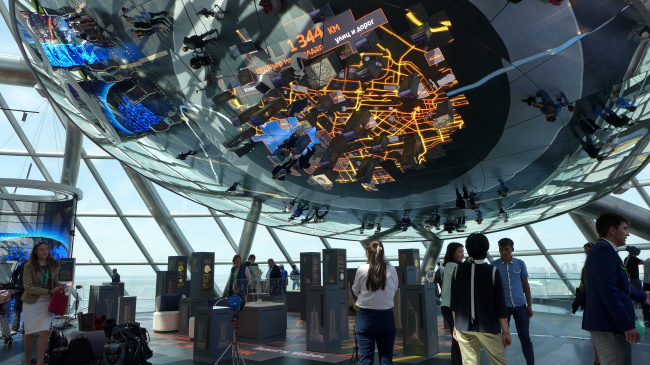 |
The top floor of the Nur Alem Kazakh pavilion at the center of the Astana International Exposition site, which runs through Sept. 10 in Astana, Kazakhstan. (Joel Lee/The Korea Herald) |
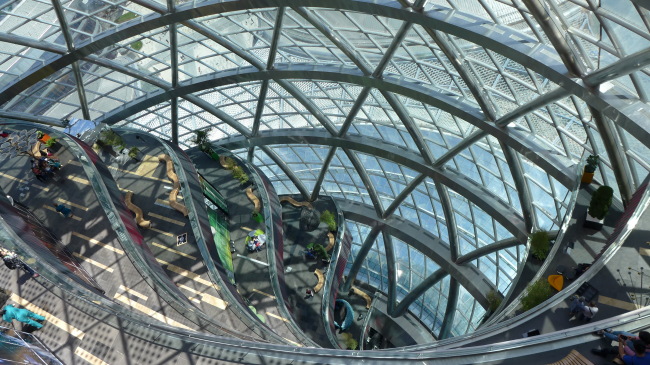 |
The interior of the Nur Alem Kazakh pavilion at the center of the Astana International Exposition site, which runs through Sept. 10 in Astana, Kazakhstan. (Joel Lee/The Korea Herald) |
Korea: Future energy, smart life
The Korean pavilion showcases the country’s future energy vision combining renewable sources and information and communications technology solutions. The centerpiece of the pavilion is a show that seamlessly fuses a graphic movie and dazzling dance by Kazakh artists on stage, where Kazakh boy “Astan” learns the value of green energies through Korean girl “Ara” on a journey leading to eco-friendly Jeju Island in Korea.
In the final section following the performance, visitors learn about Korea’s 10 key energies and related technologies -- wind, solar, energy-independence, smart energy building, home Internet of Things, intelligent microgrid, batteries, energy storage, smart home heating and fuel-cell cars -- on a tablet PC that is wirelessly connected to incandescent poles.
Korea has the largest pavilion of all the participating countries. The venue was organized and hosted by the Ministry of Trade, Industry and Energy and Korea Trade-Investment Promotion Agency, respectively.
“We heard a lot of buzz about the Korean pavilion that it was amazing,” said Astana resident Svetlana Zhivova in an interview. “The dramatic performance was so creative, beautiful and poignant. The message was very clear and easy to understand -- that we cannot go about our business polluting the earth with dirty energies.”
Park Jae-hee, a Korean university student who volunteered at the event, said he knew of home IoT technologies before the expo, but learned new lessons including that energy can be harmonized across homes through an urban control center. “As Astana is on flat land, there is a lot of potential for wind energy. Also the sun rises early and sets late here, so I think cooperation in solar energy holds great potential, too,” he said.
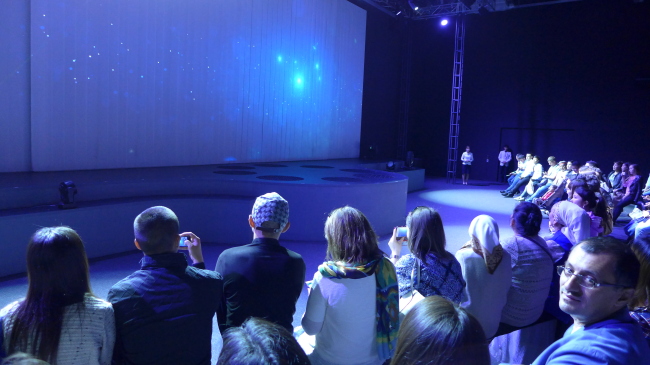 |
The centerpiece of the Korean pavilion is a show that seamlessly fuses a graphic movie and dazzling dance by Kazakh artists on stage. (Joel Lee/The Korea Herald) |
 |
The centerpiece of the Korean pavilion is a show that seamlessly fuses a graphic movie and dazzling dance by Kazakh artists on stage. (Joel Lee/The Korea Herald) |
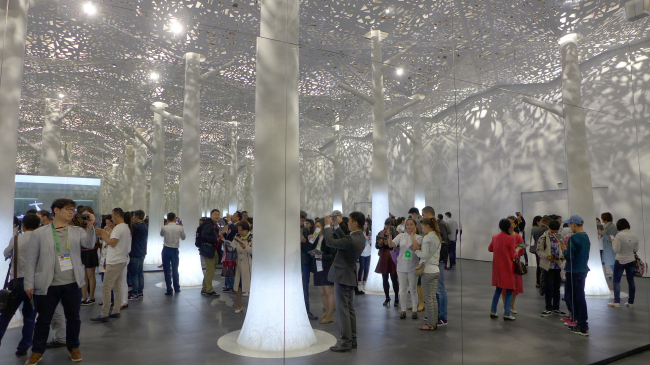 |
In the final section following the performance, visitors learn about Korea’s 10 key energies and related technologies. (Joel Lee/The Korea Herald) |
China: Future energy, green silk road
The Chinese pavilion, themed on “future energy, green silk road,” offers a panorama of the country’s historic, gargantuan transition from traditional energies to more sustainable ones, encompassing petrochemicals, solar, wind and nuclear.
China’s energy policies and ambitions are centrally tied to, and buttressed by, its global geostrategic initiative “One Belt, One Road” project, which aims to link Asia, Europe and Africa through land and sea-based trade routes and infrastructure development.
“What I learned here is that China’s strategy is multipronged,” said Jurgen Ackermann, managing director of Germany-based trading company Rolandtecnic, in an interview. “China’s idea is not to rely on one energy source but many, and reducing its reliance on fossil fuel. It is reassuring that a country with an enormous appetite for energy has come to its senses in using renewables.”
Noting that Germany has made a decisive break with nuclear power and embraced renewables -- particularly wind and solar -- following the Fukushima nuclear catastrophe, the German stressed that green energies are generated bountifully from nature, but the costs of developing technologies to harness them are higher than those needed for traditional sources, chiefly oil, natural gas and coal.
“This cost factor is missing in this expo,” he pointed out, adding, “Without it, you cannot push development forward.”
To bridge the gap between advanced economies and developing ones in terms of sustainable energy capacity, the front-runners must help the followers catch up by sharing their technological and managerial expertise, he expounded.
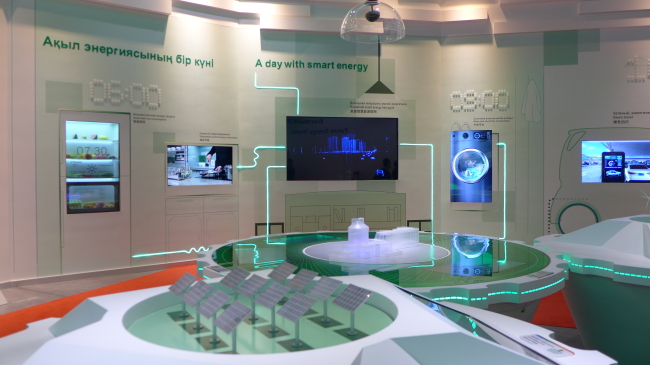 |
The Chinese pavilion (Joel Lee/The Korea Herald) |
 |
The Chinese pavilion (Joel Lee/The Korea Herald) |
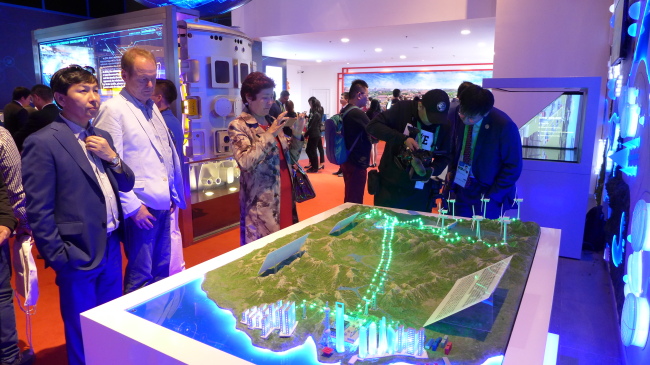 |
The Chinese pavilion (Joel Lee/The Korea Herald) |
Russia: Arctic icebreaker, exploration
For Russia, which has increasingly carved out its geostrategic interests across Eurasia, the Arctic has been a blue ocean of commercial and scientific possibilities, owing to its vast reservoirs of oil, natural gas, nickel, platinum and other minerals and resources.
Russia dedicated its pavilion to its initiatives and plans surrounding the polar region, featuring nuclear-powered icebreaker “Leader,” energy-carrying ships, a large chunk of an Arctic iceberg, hydropower and hydrocarbon solutions as well as other technological breakthroughs and commercial and research projects.
“The Arctic is full of natural resources, but we first have to break the ice to get there using an icebreaker,” Madina Kanafina, a Kazakh student studying transport logistics in the US and guide at the pavilion, told The Korea Herald. “Because the ice sheets are thick -- up to 4 meters -- a nuclear-powered icebreaker is needed. A conventional icebreaker can only break up to 2.8 meters.”
After a new route is opened up by an icebreaker, various ships carrying oil, natural gas and other minerals follow, she said, adding scientific research and development of the region also forms an important part of Russia’s Arctic diplomacy.
The Northern Sea Route -- a new shipping route defined by Russia as lying east of Novaya Zemlya and running along the Russian Arctic coast from the Kara Sea, along Siberia, to the Bering Strait -- will greatly reduce the time and cost of travel as well as shipping, the Kazakh explained.
As Arctic ice caps melt at an accelerating rate, traffic and commerce through the route are expected to increase, according to experts. It is forecast to cause dramatic shifts in trade flows between Asia and Europe, diversions of trade within Europe, heavy shipping traffic in the Arctic and a substantial drop in cargo through the Suez Canal. These profound changes are also likely to add substantial pressure on the already precarious Arctic ecosystem.
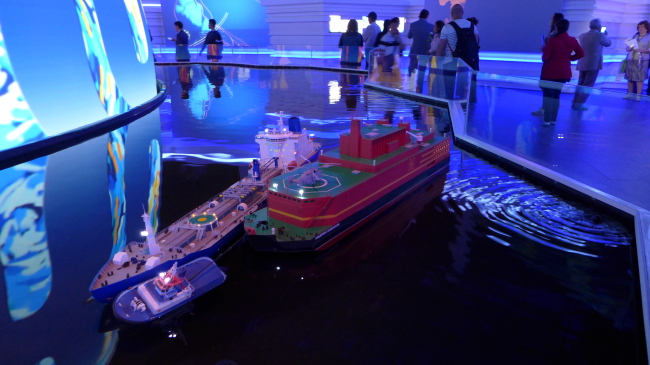 |
The Russian pavilion (Joel Lee/The Korea Herald) |
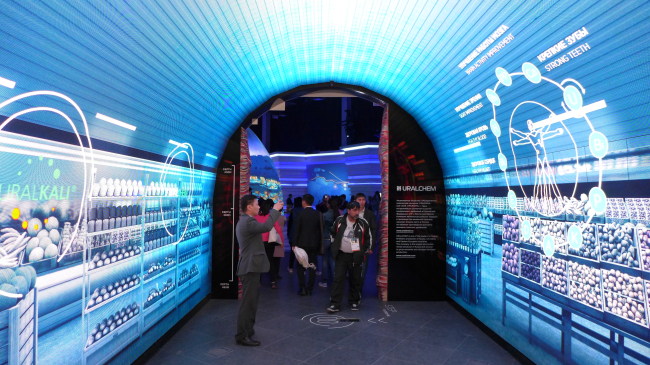 |
The Russian pavilion (Joel Lee/The Korea Herald) |
 |
The Russian pavilion (Joel Lee/The Korea Herald) |
Switzerland: Energy-efficient Swiss village Similar to Switzerland’s direct democracy studiously engaging its citizens, the Swiss pavilion is an enlightening playground of stations that illuminate energy innovations the country has spawned and wants to share with the rest of the world.
The venue has an ultra-modern, autonomously powered mountain cabin, the inside of which plays a film on innovative solar energy solutions. A live culinary show has a Swiss chef who cooks famous national dishes using environmentally friendly recipes. A short film spotlights conflicts surrounding drinking water and the importance of global cooperation in managing the precious resource.
The pavilion mirrors real-life efforts made by Swiss citizens and society as they strive to save energy, optimize the use of resources and strengthen international cooperation in the field.
“Our future energy policies and direction are well reflected in this pavilion, as we have voted to phase out nuclear power and switch to renewables in a national referendum in May,” said Manuel Salchli, director of the Swiss pavilion and commissioner of section, in an interview.
“Our new energy strategy also outlines ways to be more efficient in developing, harnessing, distributing and operating green energies. For the time being, these energies are more expensive than traditional ones, so we have to be more efficient at keeping the costs down through innovations, which is addressed at the Swissnex innovation lab here.”
Noting that 63 percent of energy in Switzerland comes from renewables (60 percent hydropower and the rest from solar, wind and thermal power), Sachli said the government and people have decided to invest more in green sources, particularly solar.
“We have homes powered completely autonomously without any input from outside. Our startups are developing new technologies to produce the necessary equipment and solutions in large quantities,” he said.
Acknowledging the country’s nuclear industry lobbied heavily in the previous referendum, he said, “Our people have decided to phase out nuclear power knowing they have to invest more and install alternative sources in their private homes. It was helped by our high national environmental consciousness.”
By Joel Lee, Korea Herald Correspondent (
joel@heraldcorp.com)
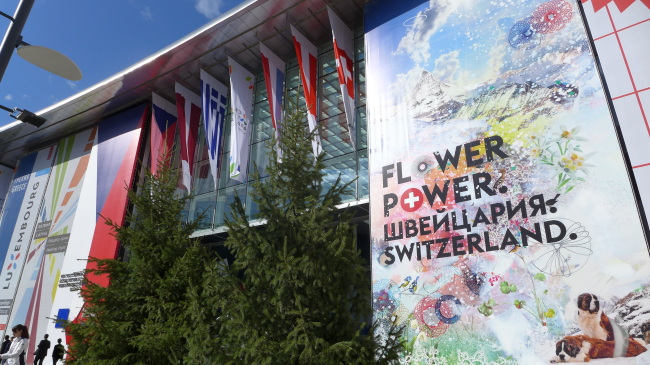 |
The Swiss pavilion (Joel Lee/The Korea Herald) |
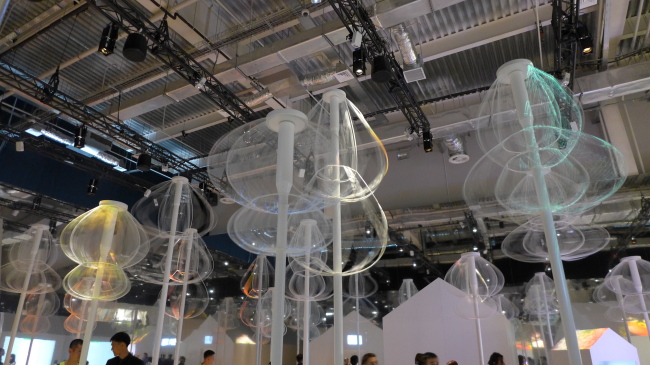 |
The Swiss pavilion (Joel Lee/The Korea Herald) |
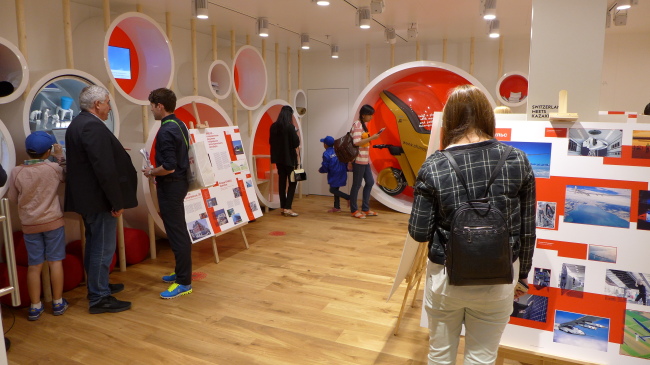 |
The Swiss pavilion (Joel Lee/The Korea Herald) |




















![[Exclusive] Hyundai Mobis eyes closer ties with BYD](http://res.heraldm.com/phpwas/restmb_idxmake.php?idx=644&simg=/content/image/2024/11/25/20241125050044_0.jpg)
![[Herald Interview] 'Trump will use tariffs as first line of defense for American manufacturing'](http://res.heraldm.com/phpwas/restmb_idxmake.php?idx=644&simg=/content/image/2024/11/26/20241126050017_0.jpg)
![[Herald Review] 'Gangnam B-Side' combines social realism with masterful suspense, performance](http://res.heraldm.com/phpwas/restmb_idxmake.php?idx=644&simg=/content/image/2024/11/25/20241125050072_0.jpg)